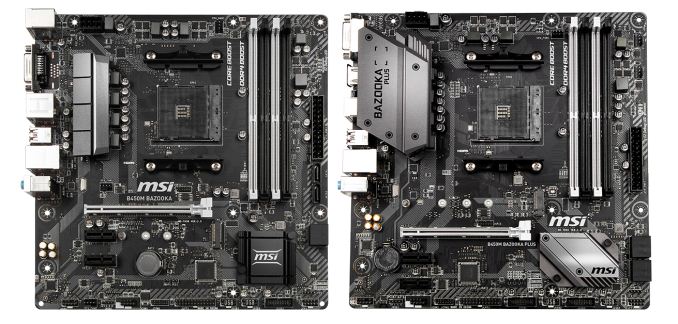Analyzing B450 for AMD Ryzen: A Quick Look at 25+ Motherboards
by Gavin Bonshor on July 31, 2018 8:00 AM ESTMSI B450M Bazooka and
MSI B450M Bazooka Plus
The B450M Bazooka and B450M Bazooka Plus are a pair of microATX motherboards from MSI’s entry-level Arsenal Gaming range. Both models share the same PCIe configuration and layout with a single full-length PCIe 3.0 x16 slot and two PCIe 2.0 x1 slots. Both boards share the same pairing of onboard audio and network controllers with the Realtek ALC892 8-channel audio codec and Realtek 8111H Gigabit LAN controller both being featured.

MSI B450M Bazooka (left) and MSI B450M Bazooka Plus (right) microATX motherboards
The visuals are dominated by a black PCB with an industrial looking grey pattern printed on, with the main aesthetic differences between the two boards coming in the way of the heatsinks; the B450M Bazooka Plus has a bigger power delivery heatsink and has a light metallic grey look. The B450M Bazooka has a more basic looking set of heatsinks. Both models look to have a 6-phase power delivery operating in a 4+2 configuration.
While the B450M Bazooka Plus looks to be the more premium of the two microATX offerings, it has support for DDR4-3333 whereas strangely the B450M Bazooka has the ability to handle faster memory out of the box, with DDR4-3466 supported. Both models have a total of four memory slots meaning up to a maximum of 64 GB of system memory can be installed.
The options on both boards for storage are identical with both boards having four SATA 6 Gbps ports and a single PCIe 3.0 x4/SATA M.2 slot which allows drives up to a size of M.2 22110 (22 x 110 mm). The B450M Bazooka has two right-angled SATA ports with having straight angled connectors, while the B450M Bazooka Plus features four right-angled connectors.
Another subtle difference is the B450M Bazooka Plus adds another USB 3.1 5 Gbps header giving the capability to add up to four ports, whereas the B450M Bazooka has a single USB 3.1 5 Gbps header. Both boards can support an additional four USB 2.0 ports thanks to a pairing of USB 2.0 headers. For users looking to add extra RGB LED lighting in addition to the LED lighting onboard, the B450M Bazooka has a single 5050 RGB header, while the B450M Bazooka Plus has two.

MSI B450M Bazooka (top) and MSI B450M Bazooka Plus (bottom) rear panels
On the rear panel, both boards have four USB 3.1 5 Gbps ports, two USB 2.0 ports, an HDMI 1.4 output, a DVI-D output, three 3.5mm audio jacks due to the Realtek ALC892 audio codec, a single LAN port controlled by the Realtek 8111H Gigabit networking chip and a PS/2 combo port. The B450M Bazooka Plus has the added benefits of a BIOS Flashback+ button.
Both boards aim to win users looking to build a smaller budget gaming system, but without sacrificing on memory capacity and PCIe 2.0 x1 support by going for a small form factor such as Mini-ITX. The B450M Bazooka has better memory support on paper, while the B450 Bazooka Plus has better-styled heatsinks and increased RGB capabilities through a pairing of 5050 RGB headers. No pricing is currently available for the B450M Bazooka Plus, but the regular B450M Bazooka is set to retail for $84.99 at launch.






















62 Comments
View All Comments
sh009vf5ik1a - Saturday, January 18, 2020 - link
Heads up on the Gigabyte B450 DS3H...This article pretty clearly states ECC memory is supported on this board, and so does Gigabyte's product page, however it fails to mention that 'supported' means just boot support. The actual Error Checking and Correction features are missing and unable to be leveraged.
I purchased this board purely based on this article for the sole reason of having a cheap ECC setup. Combined it with a Ryzen 2600 and Unbuffered Kingston ECC memory, and found that its impossible to get ECC working.
The system boots and works, but you do not get ECC functionality.
chrcoluk - Monday, August 30, 2021 - link
I read on reddit someone wrongfully stated the 2nd 16x slot is only pci gen 2. I wondered how they got this info, I then came across this review, which also states the 2nd 16x slow is gen 2.According to the manual both slots are gen 3 and both are hooked to the cpu.
I have confirmed this as I now use an asmedia 1604 sata card, on post it reports what pci-e mode its in, if I use any of the x1 slots it reports gen 2 x1, if I use either of the x16 slots it reports gen 3 x1 (its limited to one lane). I actually have even moved the gpu to the second x16 slot as its easier to plug in cables to the sata card when its in a higher slot and even gpuz reports the gpu is on pcie gen 3.
Whats the lesson? read the manual, test and dont take what a media rep tells you for gospel ;)